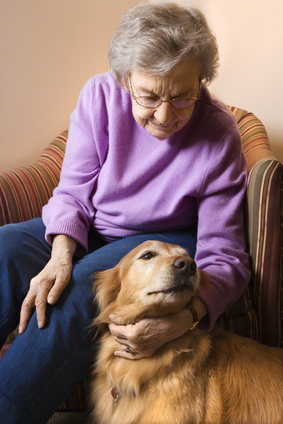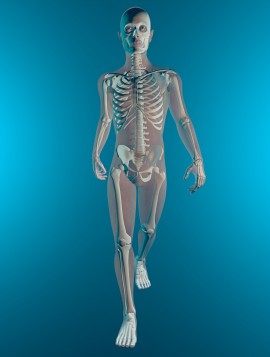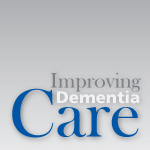 Can a pet improve the quality of life for a human? Those of us who own pets know they make us happy. But growing scientific research is showing that our pets can also make us healthy, or healthier. That helps explain the increasing use of animals — dogs and cats mostly, but also birds, fish and even horses — in settings ranging from hospitals to nursing homes.
Can a pet improve the quality of life for a human? Those of us who own pets know they make us happy. But growing scientific research is showing that our pets can also make us healthy, or healthier. That helps explain the increasing use of animals — dogs and cats mostly, but also birds, fish and even horses — in settings ranging from hospitals to nursing homes.
Nursing homes were one of the first settings to graciously open their doors to the concept of pet therapy, which was developed by Therapy Dogs International (TDI) more than 30 years ago. Today, therapy dogs and cats are registered from all types of breeds, and many are rescue animals. In 2012, there were roughly 25,000 therapy dogs registered. All therapy dogs and handlers are volunteers and are located in all 50 states. The typical therapy dog is at least 1 year of age, and each dog must pass a temperament evaluation and demonstrate appropriate behavior around people with the use of some type of service equipment (e.g., wheelchairs or crutches) in order to become a therapy dog.
It is profoundly moving to see how dogs and cats have the ability to help calm and soothe agitated individuals while lifting the spirits of those who are sad and lonely. They provide a medium for physical touch and display unconditional affection for those who may live isolated lives. Therapy pets elicit responses from some nursing home patients who are typically withdrawn and limited in their abilities. Stroking the back of a dog leads to more movement from the patient and, consequently, increased physical activity. The introduction of dogs and cats increases interaction among individuals and promotes a positive change in self-esteem.
Over the last several decades, multiple studies have measured aspects of human interactions with pets (Katcher, Friedman, Goodman & Goodman, 1998; Millot & Filatre, 1986; Stallones, Marx, & Johnson 1990) and demonstrated validity and reliability. Evidence suggests that pets may enhance self-esteem in patients/people and may assist them in socializing with one another (Zimmer, 1996). Several studies report positive social behavior changes after introducing an animal into the nursing home environment or hospital. The Australian Joint Advisory Committee on Pets in Society conducted a six-month study of the interaction of 60 nursing home residents with a dog. Using pre- and post-test questionnaires, they found positive behavior changes in interest and conversation and an increase in participation in activities of daily living (Salmon, Hogarth-Scott & Lavelle, 1982).
Studies show that pets can aid in relaxation, lower one’s blood pressure, promote healing and prolong life. With the addition of a well-trained handler/health-care worker, the mere presence of a dog may facilitate therapeutic intervention with the non-communicative patient, assist in recall of memories and help sequence temporal events in patients with head injuries or chronic degenerative diseases of the brain such as Alzheimer’s disease, as well as teach appropriate behavior patterns to those with emotional disabilities (Brickel, 1991). According to the National Institutes of Health, among older people, the ownership of pets does not help the general illness status but does act in combating depression. Pet therapy has had a more positive response in nursing homes in comparison to arts and crafts or visitors coming in for the day. Indeed, visits with therapy pets encourage reminiscence and social interaction and result in stress relief and incidental physiotherapy (Island, 1996).
Furthermore, Lynch, Thomas and Weir (1993) examined marked physiological responses in patients who had a dog to pet. The heart rate of a patient with dementia decreased by five beats per minute when he was introduced to a dog and was allowed to pet him. Even managed care organizations are studying the idea of price breaks for pet owners. In a prospective yearlong study of 938 Medicare Advantage enrollees, beneficial effects of pet ownership on the general health of senior citizens were suggested (Siegel, 1990). Improvements in the quality of life in nursing homes have been suggested by a survey of the effectiveness of a pet therapy program with monthly visits to nursing homes in Florida. Commonly reported effects of the visits included shared experiences among residents and greater socialization among residents, and it gave them something to anticipate. A pet therapy program appeared to improve the quality of life for some residents (Yates, 1987).
The scientific evidence is plentiful that pet therapy is a great adjunct to improve the quality of life of older adults. It may not be possible to have a therapy dog or cat that lives at every facility, but it might be possible to have a therapy dog visit your facility periodically. Luckily, Therapy Dogs International (TDI) has 25,000 U.S. dog/handler teams whose purpose is to provide comfort and fulfill this need of therapy pets for each facility. A visit by a therapy dog/handler is absolutely free, and TDI will work with an individual facility to identify the best days and times for visits. TDI also provides liability and accident insurance to its volunteer teams. The teams have been carefully tested by qualified evaluators to ensure the well-being of those being visited, and all dog records are reviewed continuously and updated as recommended by the American Animal Hospital Association.
To request a TDI dog/handler team visit, send a request on facility letterhead with information about the facility and the type of visits you are seeking. Include a contact name and number. Fax to (973) 252-7171. Therapy Dogs International , 88 Bartley Road, Flanders, NJ 07836, Phone: (973) 252-9800, Email: tdi@gti.net, website: www.tdi-dog.org
By Jon Anderson, PT, Keystone Therapy Resource
 We currently have leadership opportunities in the following locations: Victoria, TX and Clarion, IA. For details please click on the links above or contact Jamie Funk at (877) 595-0509 or e-mail jfunk@ensignservices.net.
We currently have leadership opportunities in the following locations: Victoria, TX and Clarion, IA. For details please click on the links above or contact Jamie Funk at (877) 595-0509 or e-mail jfunk@ensignservices.net.





 On July 10th CMS hosted a National Provider Call that focused on the goal of improving dementia care in nursing homes. This National Partnership is focused on care that is person-centered, comprehensive, and interdisciplinary. During the call, care approaches that are person-centered and individualized were highlighted, and facility systems and tools to enhance care were discussed.
On July 10th CMS hosted a National Provider Call that focused on the goal of improving dementia care in nursing homes. This National Partnership is focused on care that is person-centered, comprehensive, and interdisciplinary. During the call, care approaches that are person-centered and individualized were highlighted, and facility systems and tools to enhance care were discussed.